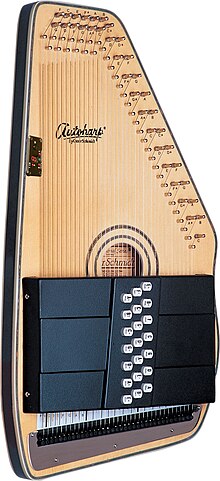Autoharp
The autoharp is a box zither that has been used in bluegrass , folk and country music in the USA since the late 19th century . The name Autoharp has been a registered trademark since 1927 .
inventor
The inventor of the Autoharp is not certain. Initially, Charles F. Zimmermann was suspected to be the author, as he had applied for a patent for a similar instrument in the USA in 1882. In contrast to the instrument known today as the autoharp, the one developed by Zimmermann was a kind of double zither in the shape of a butterfly, in which the strings on each of the two instrument sides were given a different tuning.
The autoharps in use today go back to a development by the German Karl August Gütter from Markneukirchen , who at around the same time built an instrument he himself called the “Volkszither” and applied for a patent in England around 1883. What is certain is that, after Charles Zimmermann got to know the instrument on a visit to Germany, he applied for a patent on Gütter's invention in the USA, made it very popular there under the name “Autoharp” and sold it successfully.
functionality
Similar to a guitar , the strings of the autoharp are torn with a plectrum , plucked with the fingers or struck. The free hand operates a system of felt buffers using a keyboard or an offset button mechanism. The button assignment is by default as follows:
| E ♭ | B ♭ | F. | C. | G | D. | A. | ||||||||
| F 7 | C 7 | G 7 | D 7 | A 7 | E 7 | H 7 | ||||||||
| A ♭ | B ♭ 7 | Cm | Gm | Dm | At the | Em |
When a chord is struck , all strings are muted except those required for the chord. Depending on the type, the autoharp has up to 36 strings and a range of two to four octaves . In contrast to the lying zither, the autoharp is also played standing upright or hung around the neck. It is considered an easy-to-learn instrument.
distribution
The Autoharp became famous from the end of the 1920s through the Carter Family . Sara Carter in particular played it both as a melody-leading instrument and as accompaniment, but the rest of the family, such as "Mother" Maybelle Carter and June Carter , the wife of Johnny Cash , also used the autoharp frequently.
Bill Clifton is another country musician who made the autoharp popular in the 1960s. In the 1970s, Steve Hackett a . a. the instrument on the Genesis album Wind & Wuthering . John Sebastian from The Lovin 'Spoonful used the autoharp frequently. More recent examples of the use of autoharp in pop music are the English musicians Natasha Khan ( Bat for Lashes ), PJ Harvey and Martin Molin ( Wintergatan ).
Some singers of the light North Indian classical music use an autoharp without a keyboard instead of the usual Swarmandal for their own accompaniment.
literature
- Irwin Stambler, Grelun Landon: Encyclopedia Of Folk, Country And Western Music . St. Martin's Press, New York / London 1969, pp. 18th f .
